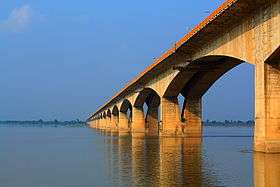Mahatma Gandhi Setu
| Mahatma Gandhi Setu | |
|---|---|
 A view of Mahatma Gandhi Setu | |
| Coordinates | 25°37′19.0″N 85°12′25.7″E / 25.621944°N 85.207139°ECoordinates: 25°37′19.0″N 85°12′25.7″E / 25.621944°N 85.207139°E |
| Carries | 4 lanes of roadway and pedestrian pathways each side |
| Crosses | Ganga River |
| Locale | Patna - Hajipur |
| Official name | Mahatma Gandhi Setu |
| Maintained by | National Highways Authority of India |
| Characteristics | |
| Design | Girder bridge |
| Material | Concrete and steel |
| Total length | 5.75 km (3.57 mi) |
| Width | 25 m (82 ft) |
| Number of spans | 47 |
| Piers in water | 40 |
| Clearance below | 265 |
| History | |
| Designer | Gammon India |
| Construction begin | 1972 |
| Construction end | 1982 |
| Opened | May 1982 |
| Statistics | |
| Toll | No (revoked)[1] |
Mahatma Gandhi Setu (also called Gandhi Setu or Ganga Setu) is a bridge over the river Ganges connecting Patna in the south to Hajipur in the north of Bihar.[2] Its length is 5,750 metres (18,860 ft)[3] and it is the longest river bridge in India.[4][5] It was inaugurated in May 1982 by the then Prime Minister, Mrs Indira Gandhi, inauguration took place at north end of the bridge located in Hajipur viewed by thousands of people.
Planning and Significance

The bridge was approved by the Central Government in 1969 and built by Gammon India Limited over a period of ten years, from 1972 to 1982 with total expenditure of Rs 87.22 crore at that time. . It was built to connect North Bihar with the rest of Bihar and part of national highway 19 (NH19). . Before this bridge was constructed, Rajendra Setu, opened in 1959, was the only link to North Bihar. Since then, the Vikramshila Setu has also been built across the Ganges. Two more rail-cum-road bridges are currently under construction, between Digha and Sonepur[6] and at Munger.[7]
The Indian postal department issued a commemorative postage stamp on Landmark Bridges Of India: Mahatma Gandhi Setu of denomination 0500 Paise on 17 August 2007.[8]
Engineering Details
The bridge consists 45 intermediate spans of 121.065 metres (397.19 ft) each and a span of 65.530 metres (214.99 ft) at each end.[9] The deck provides for a 7.5 metres (25 ft) wide two lane roadway for IRC class 70 R loading with footpaths on either side.[10] The cantilever segmental construction method was adopted to construct this mega bridge. Each span has two cantilever beams on both sides which are free to move at the ends. It has two lanes one upstream and the other downstream each with a width of around 6m. Both the lanes are also free from each other and are not connected anywhere. It was constructed by using 3 meter pre-casted parts being joined at both ends to complete the span. The Spans are connected by using a Protrusion which is free to move longitudinally also along the river flow. In upwards and downwards direction it is such that it allows vibration to transfer smoothly to the next span while vehicular movement without much discreteness.[11]
Traffic Congestion
In recent times, the bridge has been witnessing major traffic chaos and accidents due to exceeding number of vehicles passing over it and regularly overloading the structure. Bihar Government is planning to build two Pontoon bridges in parallel to it, in order to ease traffic.[12] Over 85,000 vehicles pass through Gandhi Setu.[13]
References
| Wikimedia Commons has media related to Mahatma Gandhi Setu. |
- ↑ Traffic eases on Gandhi Setu as Centre drops toll collection timesofindia.com
- ↑ "Destinations :: Patna".
- ↑
- ↑ "Gandhi Setu: An engineering marvel".
- ↑ longest river bridge to be rebuilt business-standard.com
- ↑ "Digha Sonepur Rail Road Bridge to be operational by 2017".
- ↑ Ganga Rail-Road Bridge
- ↑ Welcome to the Indiapost Web Site Archived February 13, 2011, at WebCite
- ↑ "Gandhi Setu: An engineering marvel".
- ↑ Gammon India Ltd. - Builders to the nation Archived February 13, 2011, at WebCite
- ↑
- ↑ "Govt planning to build 2 Pontoon Bridges parallel to Gandhi Setu in Patna". IANS. news.biharprabha.com. Retrieved 18 February 2014.
- ↑ http://www.telegraphindia.com/1160526/jsp/bihar/story_87616.jsp#.V5L5P9J97IU
See also
- List of longest bridges in the world
- List of longest bridges above water in India
- List of bridges in India
- Kacchi Dargah-Bidupur Bridge